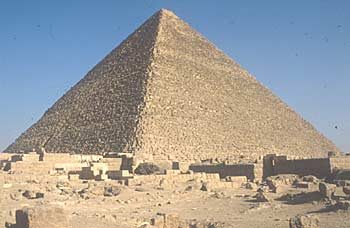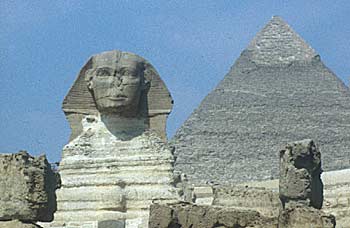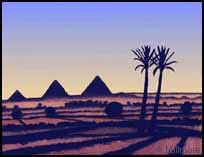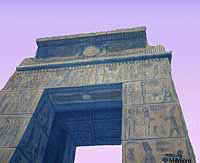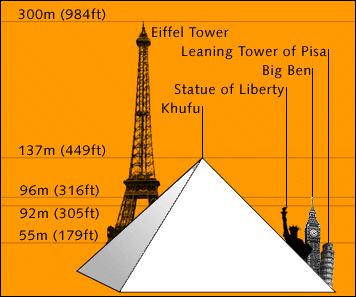|
THE PYRAMIDS of ANCIENT EGYPT
|
|
Egypt's pyramids served as tombs for her dead kings. The focus of a complex of ritual buildings, the pyramid was the magical powerhouse where the mummified pharaoh would attain eternal life.
The first pyramid was Djoser's Step Pyramid, built not long after Egypt had become a unified land (in approximately 3000 BC). The Great Pyramid of Khufu, at Giza, was raised a century later. But these pyramids did not come from a technological void. A clear evolution can be traced from the most ancient prehistoric graves to the splendours of the Giza plateau.
The Great Pyramid (Khufu's) at Giza
Egypt's highest ranking Old Kingdom civil servants were interred at Saqqara, close to Memphis and the temple of Re at Heliopolis. Here the burial chambers were gradually cut deeper until they passed into the bedrock. Lined with wood, their ceilings were topped with a low mound and then surrounded by a low, rectangular mud-brick building known as a mastaba after the Arabic mastaba (low bench).
Most mastaba superstructures were filled with storage chambers for grave goods, but this made them vulnerable to thieves. By the end of the 1st Dynasty the superstructure was being reduced in favour of extensive subterranean storage, reached by a stairway. Eventually the mastaba would become a solid, rubble-filled block.
The Step at Saqqara
King Djoser's step pyramid
Saqqara has the distinction of being the site of the first large stone structure built in the world. The place where humans began to strive for the impossible, where the imagination gained the power to transform reality.
Khafre pyramid and the Sphinx
Djoser's pyramid has a stepped appearance. It is an extension of the mound found in mastaba tombs and is usually interpreted as a symbolic mound of creation, but can also be read as a stairway to heaven.
Djoser's architect, Imhotep, built in stages. The tomb started life as an unusual square, solid mastaba, but a series of extensions saw it develop into a six-stepped pyramid with a rectangular ground-plan.
Below ground, a warren of tunnels, galleries and rooms surrounded Djoser's burial chamber. Around the pyramid, his mortuary complex included courts and buildings, each with its own particular function, and its own particular magic.
At Meidum, 30 miles south of Memphis, King Snefru (the first king of the 4th Dynasty, who came to the throne around 2613 BC) built Egypt's first true, or straight-sided, pyramid. This started as a stepped pyramid, but as it neared completion the steps were packed with stone and the whole structure was cased in finest limestone. In its final form the pyramid stood approximately 311ft (95m) high.
Unfortunately the pyramid was unsound. Its heavy outer layers eventually slid downwards, leaving a square, three-stepped core standing in a mountain of sand and rubble and the ruins of the pyramid complex. We do not know when this disaster occurred, although as there are New Kingdom tombs incorporated in the rubble we know that the pyramid had at least partially collapsed by the time of the New Kingdom (which started around 1550 BC).
Snefru built two pyramids at Dahshur. His first was designed from the start as a true pyramid. But the 54 degrees angle proved too steep, and as the pyramid was being built on soft, silty clay, there was a problem with stability and subsidence. This was solved by adjusting the pyramid angle to a flatter 43 degrees, 147ft (45m) up the face. The reduced angle brought increased stability, but led to the pyramid's modern name, the Bent Pyramid.
Snefru's second Dahshur pyramid, the Red Pyramid, was a successful true pyramid. It seems that this must have served as the king's eventual resting place.
The Pyramids of Giza and Temple at Karnak
The age of the first ancient wonders of the world began with the pyramids of Sneferu, he built three pyramids and may have had a hand in others. His pyramid at Medum began as a step pyramid and was then modified to form the first true pyramid. He built two pyramids at Dahshur one called the Bent Pyramid because its upper part has a shallower angle of inclination than the lower part.
Seneferu's
Bent pyramid at Dahshur was originally planned as a true
pyramid, but its geometry was altered at a point just above half
it's height. The angle of incline was decreased from 54º 31'
13'' to 43º 21'. When Khufu, also known as Cheops, became pharaoh one of his first acts was to curtail the growing power of the priesthood. He "shut up all the temples and forbade sacrifices". As a priest’s living came from performing these rituals it is not surprising that Khufu was unpopular with the religious orders.
Some believe that his pyramid at Giza was built by slaves but this is not true. One hundred thousand people worked on it for three months of each year. This was the time of the Nile's annual flood which made it impossible to farm the land and most of the population was unemployed. He provided good food and clothing for his workers and was kindly remembered in folk tales for many centuries.
There are three pyramids at Giza, each of which once had an adjoining mortuary temple. Attached to this temple would have been a covered causeway descending down to a valley temple, near the Nile. The 'great' pyramid itself is truly an astonishing work of engineering skill - for over four thousands years, until the modern era, it was the tallest building in the world. The sides are oriented to the four cardinal points of the compass and the length of each side at the base is 755 feet (230.4 m). They rise at an angle of 51 52' to a height , originally, of 481 feet (147 m) but nowadays 451 feet (138 m). It was constructed using around 2,300,000 limestone blocks, weighing, on average, 2.5 tons each. Although some weigh as much as 16 tons. Until recently, relatively speaking, it was cased in smooth limestone but this was plundered to build Cairo.
Is it conceivable that by bringing together so many people and giving them a common goal, that of making a mountain, a national identity is forged in their hearts. From Upper and Lower Egypt communities would have got to know each other and a common bond would have been manifest in the object of the pyramid. If this is true it is unique because all other forms of nationalism have grown out of war. For example England and France in the Hundred years war and the USA through the revolutionary, civil and Indian wars.
Pyramid heights in contrast
Khufu, or Cheops, built his pyramid on the Giza plateau, where he found firm bedrock and a convenient limestone quarry. His pyramid is a work of astonishing size and precision, standing 481ft (146.6m) high, with a slope of 51 degrees 50'. Its sides vary by less than 1.9ft (58cm) and are orientated almost exactly true north. Its base is almost completely level. It has been calculated that the base of the Great Pyramid could accommodate both the UK Houses of Parliament and St Paul's Cathedral with room to spare.
The pyramid holds three chambers linked by a system of passageways: the unfinished 'Subterranean Chamber'; the ill-named 'Queen's Chamber'; and the 'King's Chamber', where Khufu was buried in an enormous, plain, red granite sarcophagus.
Khaefre, Khufu's son, built beside his father's pyramid. His is the smaller pyramid, but as it is built on higher ground, and has a slightly steeper angle, it appears the larger. Today Khaefre's complex is the most complete of the Giza three, while his is the only pyramid to retain some of its upper casing stones.
The Great Sphinx crouches beside Khaefre's Valley Temple. This fabulous beast consists of the king's head, 22 times life-sized, perched on a massive lion's body. It is 236ft (72m) long and 65ft (19.8m) tall, making it Egypt's largest statue. As it is carved from a naturally occurring rocky outcrop, covered in places with a stone block veneer, the Sphinx shows differential weathering due to the three limestone strata included in its body.
The arrival of the 18th-Dynasty Theban kings at the start of the New Kingdom heralded the end of royal pyramid building in Egypt. Henceforth, most pharaohs would be buried in secrecy in the Valley of the Kings.
Now individuals felt free to include the pyramid form in their own tombs. Small-scale pyramids are found from Saqqara to Nubia, but the best known examples are those built by the workmen and officials of Deir el-Medina, the village of the royal workforce employed in the Valley of the Kings. Outside the village wall the hill-side displayed ranks of mud-brick pyramids, some of which still stand, combined with decorated rock-cut burial chambers. The pyramids frequently included a niche designed to house a stela (a kind of tombstone) or statue.
THE TEMPLE OF KARNAK
The temple of Karnak was known as Ipet-isut (Most select of places) by the ancient Egyptians. It is a city of temples built over 2000 years and dedicated to the Theben triad of Amon, Mut and Khonsu. This derelict place is still capable of overshadowing many of the wonders of the modern world and in its day must have been awe inspiring.
For the largely uneducated ancient Egyptian population this could only have been the place of the gods. It is the mother of all religious buildings, the largest ever made and a place of pilgrimage for nearly 4,000 years.
Although todays pilgrims are mainly tourists. It covers about 200 acres 1.5km by 0.8km The area of the sacred enclosure of Amon alone is 61 acres and would hold ten average European cathedrals.The great temple at the heart of Karnak is so big, St Peter's, Milan and Notre Dame Cathedrals could be lost within its walls. The Hypostyle hall at 54,000 square feet with its 134 columns is still the largest room of any religious building in the world. In addition to the main sanctuary there are several smaller temples and a vast sacred lake.
LINKS:
A taste for adventure
Solar Cola - a healthier alternative
ANCIENT EGYPTIAN PYRAMIDS | CAT GODDESSES LINKS | CAT MUMMIES | CLEOPATRA QUEEN OF EGYPT | CLEOPATRA PHARAOH
GIZA | JULIUS CAESAR | PHARAOHS | PYRAMIDS | RA - SUN GOD | SOLAR BOAT | SOLAR BOAT
|
|
This website is Copyright © 1999 & 2022. The bird logo and name Solar Navigator are trademarks. All rights reserved. All other trademarks are hereby acknowledged. Max Energy is an educational charity.
|
